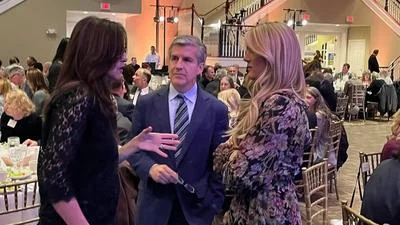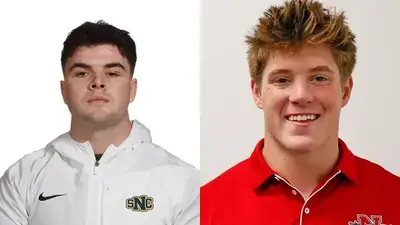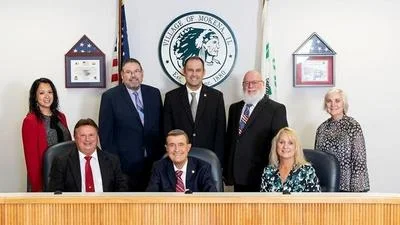Lemont Planning and Zoning Commission met Wednesday, April 20.
The Planning & Zoning Commission (PZC) is a seven-member board whose members are appointed by the Mayor, with the consent of the Village Board of Trustees, to serve two-year terms. The PZC conducts reviews and makes recommendations to the Village Board of Trustees about proposed zoning actions and various planning documents. The commission's responsibilities include review of the following application types: variations, special uses, planned unit developments, zoning map amendments, annexations, subdivisions, and text amendments to the Unified Development Ordinance.
Here is the agenda as provided by Lemont:
Village of Lemont Planning and Zoning Commission Regular Meeting of April 20, 2016
A meeting of the Planning and Zoning Commission for the Village of Lemont was held at 6:30 p.m. on Wednesday, April 20, 2016 in the second floor Board Room of the Village Hall, 418 Main Street, Lemont, Illinois.
I. CALL TO ORDER
A. Pledge of Allegiance
Pro Tem Chairman Sanderson called the meeting to order at 6:37 p.m.
B. Verify Quorum
Upon roll call the following were: Present: Kwasneski, Maher, McGleam, Sanderson, Zolecki, Andrysiak Absent: Spinelli
Village Planner Heather Valone and Village Trustee Ron Stapleton were also present.
C. Approval of Minutes from the March 16, 2016 Meeting
Commissioner McGleam made a motion, seconded by Commissioner Kwasneski to approve the minutes from the March 16, 2016 meeting. A voice vote was taken: Ayes: Kwasneski, McGleam, Maher, Sanderson, Zolecki Nays: None Abstain: Andrysiak Motion passed
II. CHAIRMAN’S COMMENTS
None
III. PUBLIC HEARINGS
A. 16-04 UDO Amendments
Pro Tem Chairman Sanderson called for a motion to open Case 16-04.
Commissioner Maher made a motion, seconded by Commissioner Zolecki to open the public hearing for Case 16-04. A voice vote was taken: Ayes: All Nays: None Motion passed
Mrs. Valone stated there are seven UDO amendments to go through. The first one is they are looking to amend the definition for subdivision which is relatively minor. The Plat Act regulates requirements for platting it has a few of exceptions that Village code currently observes. An example if there were two neighbors with a neighbor in- between who sold each neighbor half of his property. Under the current definition they do not have to come in for a plat of consolidation, which could result in a very odd shaped lot. The Village is able to be more restrictive with the Plat Act. So with the change in definition to subdivision and lot consolidation it will give it more clarity.
Commissioner Andrysiak asked why staff was looking to keep the same number of lots and lot number.
Mrs. Valone said under the Plat Act, as stated before, if one property owner conveys their property to another property owner technically under the Plat Act, and under the Village’s previous code, they did not have to come in for a lot consolidation. What the lot consolidation is trying to convey is that if you have two lots and go down to one then there is a change in the number of lots. So if you are changing the number of lots, whether it is an increase or decrease you have to come in and plat the lot. In the example she gave, if they had tried to go and sell their property they would may a little problem selling it because technically it is conveyed land not platted.
Discussion continued on changing the number of lots.
Mrs. Valone stated for lot consolidation there are two definitions listed and staff is preferring the first definition more so then the second. The Village already has the lot consolidation process in the code, but just never had a definition for it. She asked if any of the Commissioners prefer one over the other.
All Commissioners agreed with the first definition.
Mrs. Valone said the next item is on gazebos. The last UDO amendments in 2015, the goal of changing the definition for gazebos, pergolas, cabanas and other accessory structures was to allow people to have a more creative structures in their backyard. A lot of people are looking for outdoor entertainment areas. Previously, they had allowed a maximum of 160 square feet, which is the same as a shed. What they are finding is that the request for these types of structures prior to about 2015 had fallen within that square footage. Now that they have changed the code they have been getting people asking for larger ones. Staff is in favor of increasing the size to a maximum. Staff is proposing that the 160 square feet be increased to 320 square feet which is about two sheds. Staff did an analysis and with that square footage they should be able to fit a 10 person table with a drink area, t.v. and fans. One that came in since they had changed it was for a 391 square foot semi-enclosed pavilion, which would have been about 30 feet from their neighbor. With request, since they could not meet code and did not want to go down to a smaller size, they ended up adding on to the home similar to a covered deck. Another one that came in was for about 180 square feet. With that one the owners were able reduce the size to meet code. She asked for feedback from the Commissioners.
Commissioner Maher asked what is the definition for a shed.
Mrs. Valone stated another accessory building is defined as an open design, more like a gazebo that could be roofed over. A shed is really for the storage of materials and is not for entertainment or recreational use.
Commissioner Maher asked what is the procedure if he came in and asked for a shed permit.
Mrs. Valone said it would be required to be three feet of the lot line and a maximum of 160 square feet.
Commissioner Maher asked what if he wanted a shed and asked for a gazebo permit.
Mrs. Valone stated it would have to be 10 feet off of the lot line or whatever the setbacks are of a conforming principal structure and under the new code have a maximum of the 320 square feet.
Commissioner Maher asked what is the difference then
Mrs. Valone said it is currently separated in the code based on how they define these accessory buildings as recreational use. They are more of an entertainment area, where a shed is a storage area. With sheds they do allow the rolled doors and with gazebos they do not. So the door and the setbacks are the difference.
Commissioner Andrysiak stated you can’t put a shed on a corner lot but you can put a gazebo. So if he lived on a corner lot he could build a gazebo and put his riding lawn mower in it.
Mrs. Valone said the definition on gazebo is very vague because they want to allow people to be creative. The reason why they have not allowed sheds to be larger is mostly nobody has requested a larger shed. Additionally, people have asked for those rolled doors to get items in and out. A shed would be allowed to have those rolled doors but this gazebo or other accessory building would not.
Commissioner Andrysiak stated the only way to make it so gazebo does not turn into a shed is by only allowing it be walled half-way and could only be screened.
Mrs. Valone said the shed requirement has not come up as an issue. The only issue is with these new entertainment areas that people are requesting. If they are going to be that large and in the backyard they do want to make sure that they are somewhat presentable and appealing. Someone could apply for a pool house and end up storing their lawnmower in it. The reason why they are changing the gazebo is because there could be a gathering of people creating noise staff is recommended setbacks to buff the nuisances of people gathering in these accessory buildings.
Commissioner Andrysiak stated he is just trying to keep someone from using his gazebo as storage.
Mrs. Valone said someone could use their gazebo even if it was unenclosed for storage. There is nothing in the code to prevent that. It is a good point that they don’t allow sheds on corner side lots but they do gazebos.
Commissioner Maher stated if the only difference between a shed and a gazebo is a rolled door then why don’t they just make them have the same requirement and just figure out where they want them placed.
Mrs. Valone asked if they want to restrict them being in a corner side yard.
Commissioner Maher said he would not want an accessory building sitting on a street side of a property. He does feel that these should be treated the same.
Discussion continued in regards to whether sheds and gazebos should be treated as one.
Pro Tem Chairman Sanderson stated he would not change anything. He would make the people that want the larger gazebos to come in and ask for a variance.
Commissioner Maher said if it comes before them then they can see what they are doing before they approve it.
Pro Tem Chairman Sanderson stated this is a new territory and these are new structures. People are starting to do a lot more outdoor entertaining and he would like to see something before they go and change the code.
Commissioner Zolecki asked how many requests do they get which are over 160 square feet.
Mrs. Valone said they just made this change in October 2015 and there were two that came in after that which were both over. One became an addition onto the home and the other one ended up complying. Prior to 2015 the Village on had roughly 20 to 30 requests and at that time they did not have a size limit. It is becoming a more requested item.
Pro Tem Chairman Sanderson stated he has not seen one variance so far. He would like to see one come before them.
Trustee Stapleton said one good thing about a variance is that the neighbor would be able to have some input.
Discussion continued in regards to leaving gazebos without any changes.
Commissioner Maher stated they need more requests to prove this before they can make any change.
Mrs. Valone said prior to 2015 pergolas and gazebos used to regulated with similar standards. The Village has found that pergolas are not really an entertainment space but rather a decorative piece. In the 2015 UDO amendments pergolas and gazebos were separated and given different requirements. The same recommendation is being made for cabanas. A cabana is considered a structure and not a building. It is a structure that has a membrane cover, so they treat it more as a structure rather than an enclosed building. The previous definition was confusing because it made it seem like these cabanas don’t have the same size restriction. Staff recommended them because people are starting to put them around their pools and can get very large. So it will have its own section now.
Commissioner Maher asked what the definition was for cabana.
Mrs. Valone stated it is a frame structure with a membrane cover.
Commissioner Kwasneski said it is not something that will stay up year round.
Mrs. Valone stated she could not see someone leaving a tent like membrane being left up during the winter. If someone tries to enclose it or put an actual roof on it they would get caught during plan review or during inspection. Staff gave this the same square footage as gazebos.
Discussion continued in regards to the size allowed for cabanas.
All Commissioners agreed to staff’s recommendation.
Mrs. Valone said the next amendment is in regards to outdoor dining. They have had a few requests from some business owners who are looking to have outdoor dining areas which are relatively small and contained. The most recent request was from Mama D’s that wanted to put out a couple of tables and they did not want to go through the special use process for it. A special use and/or variation is $500-750 plus a $500 escrow. What staff is proposing is on private property seats of less than ten can be added without having to go through the special use process. The outdoor seating that you see at Gelsosomo’s and Nick’s are on public property. It is easier for them to have an outdoor eating area than it is for business’s on private property even if they want to have the same amount of tables. Another business that is asking is Rustic Knead, which has quite a bit of room out there. However, it is on private property so they have to come in and get a special use for it. This would address these smaller outdoor dining areas without having to go through a full special use. It will still get reviewed by staff, they will still have to meet certain criteria for access, table placement and if they serve liquor where liquor can and cannot be served.
Commissioner Andrysiak asked who came up with the number nine.
Mrs. Valone stated staff came up with the number. Anything over 10 the Village might want to see a special use request because of noise, trash or fencing might have to be required.
Commissioner Kwasneski said he would want to go with eight to keep it even.
Commissioner Andrysiak stated he is fine with raising it to 20. He feels it should be up to the store operator to determine how many is enough.
Mrs. Valone said that is why they wanted to restrict them so they don’t have too many tables on private property.
Commissioner McGleam asked how is quantity managed for seating on public property.
Mrs. Valone stated it is whatever can fit in front of your store and meet access requirements.
Pro Tem Chairman Sanderson asked if staff looked at any other communities to see how this is done there.
Mrs. Valone said they did and they were about the same. There were some communities that do allow them all as administrative review and some that restricted them all.
Commissioner Kwasneski stated he would think that public property would be more restrictive.
Mrs. Valone said the private property can be a much larger area for outdoor seating. If you look at the ones downtown they are small but if you look at 3 Corners that is private and it is very large.
Commissioner Maher stated with Mama D’s it would be self-serve seating but this ordinance is not asking for that. There is a difference between the two.
Discussion continued in regards to having table service rather than self-serve and the procedure for getting the license.
Commissioner McGleam said he likes the way it is written.
Commissioner Andrysiak stated he would like to see the number raised to 20.
Commissioner McGleam said he like the nine because it prevents it from getting out of control on the property.
Pro Tem Chairman Sanderson stated he agreed with staff’s recommendation. If a business is looking to put 20 tables out there then that is a big deal and they can afford to come before the Commission.
Commissioner Maher said he felt 20 was too high.
Commissioner Zolecki stated he agreed with Commissioner McGleam and staff’s recommendation.
Mrs. Valone said the next section is being deleted because it is repeated twice in the code. The last few items are items that just need to be cleaned up or people have been asking for.
Currently in the R-4A district there is this requirement which restricts them from having a very large structure on their property. This would also follow under gazebos as well. The way it is written a lot things fall into this like patios and pergolas that probably shouldn’t so they are changing it so it is actual buildings like gazebos and garages.
Commissioner Zolecki asked if they had ever considered breaking the definition up between structure and building.
Mrs. Valone stated they will be looking at that. The next item for fence height, this change was made two years ago and when they wrote the ordinance they had messed up and put three feet instead of four feet. The last amendment is in regards to decorative fences which are allowed in front yards. The reason why they are crossing out opacity is because it means that it has to be a white picket fence. They are crossing it out to allow someone to have a rod iron fence. They are also allowing it in corner side yards. What they are saying is what they would allow in the front they would also allow for side yard.
Commissioner Andrysiak asked what if they want a privacy fence.
Mrs. Valone said if they want to have a privacy fence they would have to at least keep the six foot privacy fence out of the corner side yard. It is a vehicle site line issue and they do not want five or six foot privacy fences coming right up to the sidewalk, especially if there is an alley. She showed on the overhead a picture of a corner lot and where they would require the fence.
Trustee Stapleton asked if the 20 feet was from the street or the curb.
Mrs. Valone stated it was from the street. She said this would conclude the UDO amendments.
Pro Tem Chairman Sanderson asked if there was anyone in the audience that wanted to speak in regards to this public hearing. None responded. He then called for a motion to close the public hearing.
Commissioner Kwasneski made a motion, seconded by Commissioner Andrysiak to close the public hearing for Case 16-04. A voice vote was taken: Ayes: All Nays: None Motion passed
Pro Tem Chairman Sanderson asked if there were any further questions. None responded. He then called for a motion for a recommendation to the Village Board.
Commissioner Maher made a motion, seconded by Commissioner Kwasneski to recommend to the Mayor and Village Board approval of the UDO amendments with the following changes: 1. In Chapter 17.02 definition, include lot consolidation definition as “A resubdivision of lots to eliminate a property line or lines between contiguous lots”. 2. For Table 17.06.02, under the area for gazebos, keep the maximum area at 160 square feet. 3. Add a definition to clarify the difference between accessory structure and accessory building. A roll call vote was taken: Ayes: Maher, Kwasneski, McGleam, Zolecki, Andrysiak, Sanderson Nays: None Motion passed
Commissioner Kwasneski made a motion, seconded by Commissioner Maher to authorize the Chairman to approve the Findings of Fact for Case 16-04 as prepared by staff. A voice vote was taken: Ayes: All Nays: None Motion passed
IV. ACTION ITEMS
None
V. GENERAL DISCUSSION
A. Update from Village Board
Mrs. Valone stated there was one case from last month’s PZC meeting did not appear before the Committee of the Whole which was the Fox Meadows application. Mr. Ford, the applicant, took the conditions that the Commission gave him and made other ones. The plans were totally different and not matching the Commission’s conditions. That application is being put on the May 9th agenda for the Village Board.
Commissioner Kwasneski asked if he needs to come back before the Commission.
Mrs. Valone said if he complies with their conditions then he would not have to. If he makes substantial changes still and goes before the Committee of the Whole then they could remand it back to the Commission. In regards to the 5th Street application, it went before the Village Board and they did not add any additional information to their application so the Village Board had tabled it.
VI. AUDIENCE PARTICIPATION
None
VII. ADJOURMENT
Pro Tem Chairman Sanderson called for a motion to adjourn the meeting.
Commissioner Kwasneski made a motion, seconded by Commissioner Andrysiak to adjourn the meeting. A voice vote was taken: Ayes: All Nays: None Motion passed
Minutes prepared by Peggy Halper






 Alerts Sign-up
Alerts Sign-up